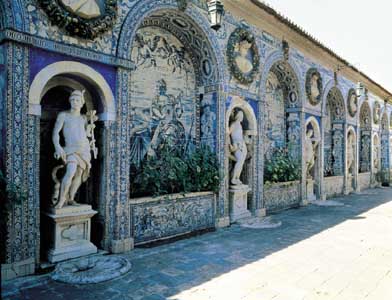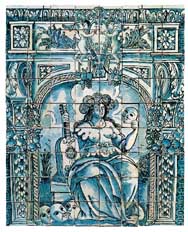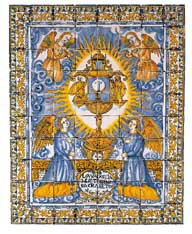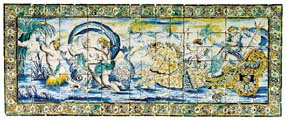|
|
|
|
|
|
|
|
|
|
|
|
|
|
 |
|
|
|
|
|
|
|
|
|
|
|
 |
|
|
|
|
|
|
|
|
The XVII Century
Figurative diversity
|
 hile figurative tiles were designed in harmony with the space in which they were to be laid, be it religious or civil, the ceramic workshops nevertheless accumulated veritable libraries of engravings which they re-used in different orders. hile figurative tiles were designed in harmony with the space in which they were to be laid, be it religious or civil, the ceramic workshops nevertheless accumulated veritable libraries of engravings which they re-used in different orders.
Hunting, warlike, mythological and satirical scenes were all transposed onto tiles, where they were freely interpreted in colour by artisans with no academic training, before either being applied to large surfaces on buildings or, on a smaller scale, being used to replace oil canvasses painted according to the European tradition.
The Church ordered small individual panels depicting saints, religious emblems and narrative scenes painted in a style that was ingenuous compared to the great religious cycles of the next century.
The more secular works found their clientele among the nobility, who used them to decorate the new palaces they built both in Lisbon and in the country following the restoration of Portugal?s independence from Spain in 1640.
The Palace of the Marquises of Fronteira in Lisbon contains one of the most important collections from this period. Alongside mythological and battle themes, we find satirical scenes known literally as "monkey business", full of irony and a sense of nonsense.
|
|
|
|
"The Gallery of the Arts",
Fronteira Palace, Lisbon, c. 1670.
photograph: (DDF-IPM)
|
|
|
|
|
|
|
|
|
 |
|
|
 |
|
|
 |
|
|
|
The Muse Thalia,,
c. 1670, MNA inv. 6914.
photograph: José Pessoa (DDF-IPM)
|
|
|
|
|
Eucharistic Allegory,
3rd quarter of the XVII century, MNA cat. 173.
photograph: José Pessoa (DDF-IPM)
|
|
|
|
|
|
|
|
|
|
|
|
|
|
|
The Retinue of Anfitrite and Poseidon,
c. 1670, MNA inv. 141.
photograph: Francisco Matias (DDF-IPM)
|
|
|
|
|
 |
|
|
|
|
|
|
|
|
"Monkey Business",
Fronteira Palace,
isbon, 3rd quarter of the XVII century.
photograph: Nicolas Lemonnier
|
|
|
|
|
|
|
|
|
© Instituto Camões, 2000
|
|
|
|